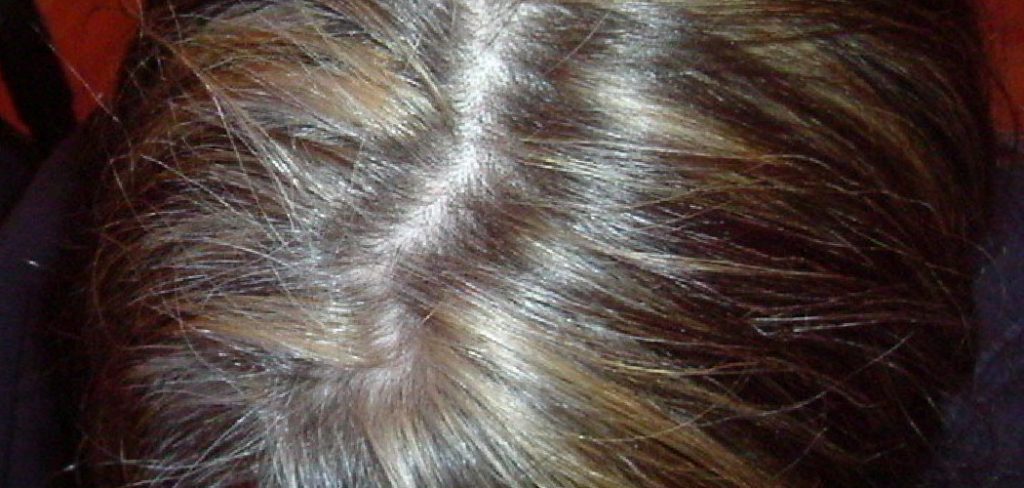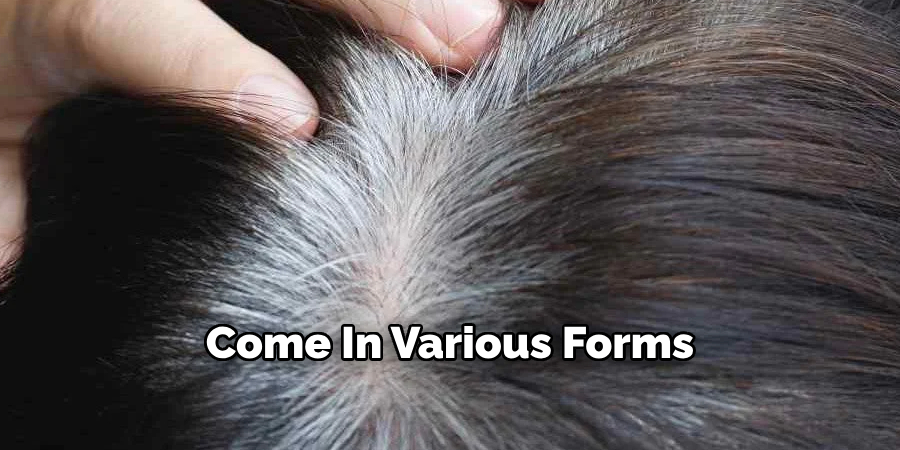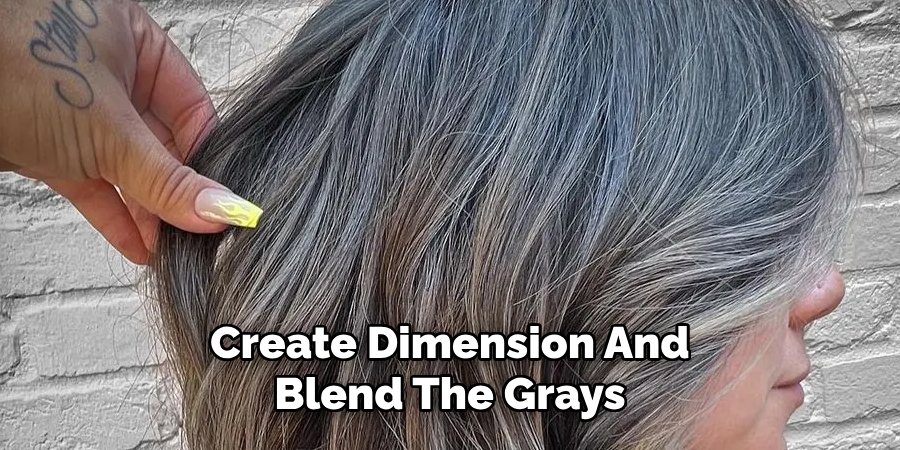Are you tired of noticing your hair greying? Are you fed up with the constant trips to the salon for touch-ups and root maintenance?
Embracing your natural gray hair can be a liberating and empowering decision. However, navigating the transitional phase as your hair grows out can sometimes be challenging, mainly when dealing with the demarcation line between colored hair and gray roots. The demarcation line, where the two colors meet, can clearly indicate the transition and may only sometimes blend seamlessly.

This guide will explore effective techniques and tips to help you hide the demarcation line and achieve a more seamless and graceful transition as you embrace your beautiful gray hair. Let’s dive in and discover how to hide demarcation line when going gray.
What Will You Need?
Before diving into the techniques, gathering all the necessary tools and products is essential. Here are some items you may need:
- Root touch-up spray or powder
- Temporary hair color
- Hair chalk or mascara
- Colored hair extensions (optional)
- Hair accessories such as headbands or scarves
Once you have everything on hand, you can explore different ways to hide your demarcation line.
10 Easy Steps on How to Hide Demarcation Line When Going Gray
Step 1. Root Touch-Up Products
One of the most common methods of hiding the demarcation line is using root touch-up products. These can come in various forms, such as powders, sprays, or pencils, and are typically applied directly onto the roots to cover up any gray hairs. They offer temporary coverage until your next hair wash and usually come in different shades to match your hair color.

Step 2. Temporary Hair Color
Another option is to use temporary hair color to blend in the demarcation line with the rest of your hair. These products are typically applied all over the hair, similar to a regular dye, but only last for a few washes. They can help soften the contrast between colors and give a more blended appearance. Ensure you choose a shade closest to your natural hair color for the best results.
Step 3. Hair Chalk or Mascara
For a temporary and creative way to hide the demarcation line, you can explore the use of hair chalk or mascara. Hair chalk is a colored pigment that can be applied directly to the hair, while hair mascara works similarly but in a mascara-like application. These products allow you to add streaks of color to your hair, effectively camouflaging the contrast between your natural hair color and the grays. They offer a fun and customizable option, allowing you to experiment with different colors and styles. Remember to choose colors that complement your hair tone for a natural and seamless blend. Remember that hair chalk and mascara are temporary solutions and can easily be washed out with shampoo.
Step 4. Hair Extensions
Hair extensions can be a game-changer when blending in gray hair. They offer a seamless way to add length, volume, and color to your hair, concealing any demarcation lines. Choose extensions that match your natural hair color and texture for the most natural-looking results. Whether clip-in extensions for a temporary solution or semi-permanent tape-in or sew-in extensions for a longer-lasting effect, hair extensions provide versatility and the ability to customize your look. Consult a professional stylist to find the best type of extensions and application method for your hair type and desired outcome. You can enjoy a seamless and beautifully blended hairstyle with hair extensions while saying goodbye to any unwanted gray hair demarcation.
Step 5. Hair Accessories
Hair accessories, such as headbands or scarves, can quickly and easily hide the demarcation line while adding style to your look. They offer versatility and creativity, allowing you to play around with different colors, patterns, and textures. You can wrap a scarf around your hair or use it as a headband to cover up any noticeable lines. Alternatively, you can use decorative clips or bobby pins to pin back certain sections of hair for a more subtle approach.
Step 6. Highlights and Lowlights
Highlights and lowlights can effectively blend the demarcation line and create a natural-looking transition between your natural hair color and the graying sections. These coloring techniques involve adding shades of lighter (highlights) or darker (lowlights) to your hair to create dimension and blend the grays. Consulting with a professional colorist is recommended to determine the best shades and placement to achieve the desired effect. Highlights and lowlights can be strategically applied to camouflage the demarcation line and create a seamless blend, giving your hair a refreshed and vibrant appearance. Remember to properly care for and maintain your colored hair to ensure the longevity and vibrancy of the highlights and lowlights.

Step 7. Gradual Trimming
Gradually trimming the ends of your hair can help blur the demarcation line and create a more gradual transition between colors. It’s essential to consult with your hairstylist on how much and how often to trim your hair to achieve the desired effect without compromising the length or health of your hair. Regular trims also help maintain the shape and style of your haircut, giving you a polished look as you embrace your gray hair.
Step 8. Embrace Your Roots
Sometimes, the best way to deal with the demarcation line is to accept and embrace your gray roots fully. Transitioning to gray hair can be a bold and empowering choice, showcasing your natural beauty and confidence. To make the process smoother, consider working with your stylist to create a haircut or styling technique that complements the growth of your gray hair. Textured hairstyles, such as soft waves or curls, can enhance the look of your transitioning hair and make the line less noticeable. Pairing this with regular deep conditioning treatments will keep your hair healthy and vibrant during the transition. You can celebrate your unique style and maximize your natural beauty by embracing your roots.
Step 9. Hair Gloss or Toning Treatments
Hair gloss or toning treatments can be a fantastic option to blend the demarcation line as you transition to gray hair. These semi-permanent treatments add shine and richness to your hair color while toning down any unwanted brassiness or stark contrasts. A gloss treatment can refresh your hair tone and enhance the gray strands, creating a more cohesive and polished look. Consult with your hairstylist to determine the best toning or glossing product for your hair type and needs, as these treatments are customizable and can be tailored to match your natural hair color perfectly.

Step 10. Patience and Positivity
Lastly, transitioning to gray hair requires patience and a positive mindset. The process may take some time, especially if you choose a gradual approach, but maintaining a positive outlook can make all the difference. Surround yourself with supportive friends or communities who celebrate natural beauty and aging gracefully. Remember, going gray is a personal and unique experience, and it’s a chance to reinvent your style while showcasing your confidence and individuality. Celebrate every transition step and focus on the beautiful, authentic look you are achieving.
Following these tips and techniques can effectively blend the demarcation line and confidently embrace your gray hair.
5 Things You Should Avoid
- Ignoring the Power of Blending Techniques: One of the biggest mistakes people make when transitioning to gray hair is not using blending techniques. Blending involves adding lowlights and highlights to your hair to create a seamless transition from your natural color to gray.
- Using Box Dye or At-Home Hair Coloring Kits: While box dye or at-home hair coloring kits may seem like a quick and easy solution for hiding the demarcation line, they can do more harm than good. These products often contain harsh chemicals that can cause damage to both your natural hair and your new gray hair.
- Skipping Regular Trims: As your hair grows, getting regular trims is essential to maintain a healthy and even length. Skipping trims can lead to split ends and uneven growth, making blending your gray hairs into your natural color harder.
- Not Using the Right Products for Gray Hair: Gray hair has different needs than pigmented hair, so using the same products you used before transitioning may not yield the best results. Look for shampoos and conditioners specifically formulated for gray hair and styling products that will enhance and complement its unique texture.
- Being Afraid of Change: It can be scary to make a significant change, like embracing your natural gray hair, but don’t let fear hold you back. Embracing your gray can be empowering and liberating, and it’s an excellent opportunity to try out new styles and looks.

Conclusion
How to hide demarcation line when going gray can be a challenging but rewarding experience. With the right techniques and products, you can effectively blend the demarcation line and embrace your natural beauty.
Consult with a professional colorist and practice patience and positivity throughout the process. Embrace this journey as a chance to showcase your confidence and individuality and celebrate your unique style every step of the way.
Now go forth and rock that gorgeous head of gray! Keep learning new hairstyles and embracing new colors. And always remember: silver is chic, sophisticated, and absolutely stunning! Happy transitioning!
you can also check it out to Grow Hair Back After Hair Loss
About the Author
Jane Hubbard is a passionate beauty expert with a wealth of experience in makeup, hair, and overall beauty techniques. After years of working as a hairdresser specialist, she followed her entrepreneurial spirit and started her own consultancy business.
Jane has always been driven by her desire to help others feel confident in their own skin, and she does this by sharing her knowledge, experiences, and practical beauty tips. Through her consultancy, she empowers individuals to embrace their unique beauty, offering tailored guidance that boosts both self-esteem and personal style.
Professional Focus
- Specializes in makeup, hairstyling, and beauty consulting.
- Provides personalized beauty advice, tips, and techniques to help individuals feel confident in their appearance.
- Dedicated to staying up-to-date with the latest industry trends and developments.
- Passionate about creating a comfortable and empowering experience for every client.
Education History
- University of Craft and Design – Bachelor of Fine Arts (BFA) in Woodworking and Furniture Design
- Woodworking Apprenticeships – Extensive hands-on training with skilled craftsmen to refine carpentry and furniture making techniques
- Online Courses & Masterclasses – Continued education in advanced woodworking techniques, design principles, and specialized tools
Expertise:
- Makeup artistry, hairstyling, and beauty consulting.
- Personalized beauty techniques to enhance confidence and self-expression.
- Educating clients on how to maintain their beauty routines at home.
